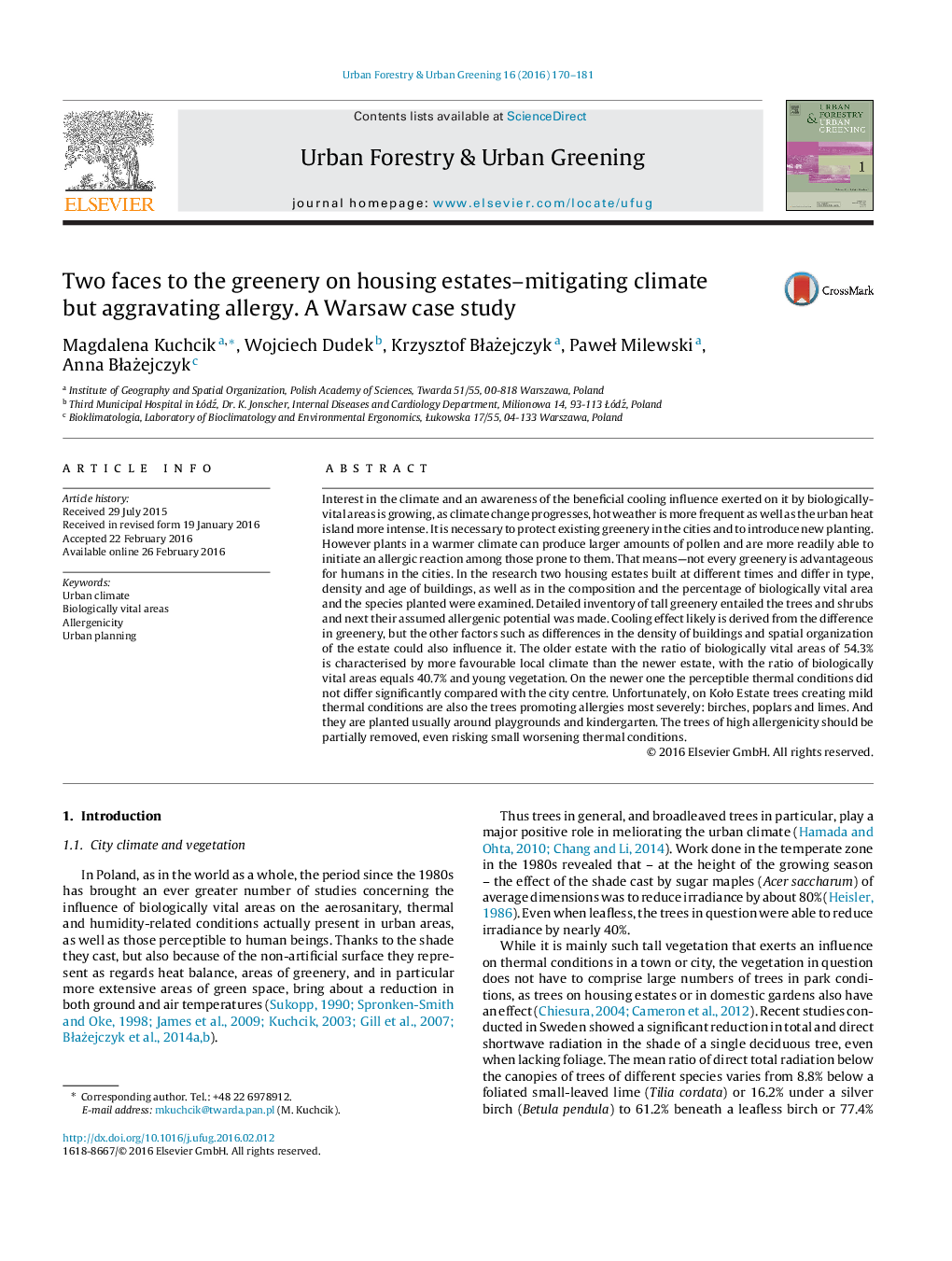| کد مقاله | کد نشریه | سال انتشار | مقاله انگلیسی | نسخه تمام متن |
|---|---|---|---|---|
| 6549765 | 160240 | 2016 | 12 صفحه PDF | دانلود رایگان |
عنوان انگلیسی مقاله ISI
Two faces to the greenery on housing estates-mitigating climate but aggravating allergy. A Warsaw case study
ترجمه فارسی عنوان
دو چهره به سبز در املاک و مستغلات - کاهش آب و هوا اما آلرژی شدید. یک مطالعه موردی ورشو
دانلود مقاله + سفارش ترجمه
دانلود مقاله ISI انگلیسی
رایگان برای ایرانیان
کلمات کلیدی
آب و هوای شهری، مناطق حیاتی حیاتی، آلرژن بودن، برنامه ریزی شهری،
ترجمه چکیده
علاقه به آب و هوا و آگاهی از تأثیر خنک کننده مفید بر روی آن توسط مناطق حیاتی زیست محیطی، در حال رشد است، به دلیل تغییرات آب و هوایی، آب و هوای گرم و همچنین گرمای گرم تر شهری بیشتر است. لازم است حفاظت از گیاهان موجود در شهرها و معرفی کاشت های جدید لازم باشد. با این حال گیاهان در آب و هوای گرما می توانند مقادیر بالایی از گرده را تولید کنند و به راحتی قادر به ایجاد واکنش های آلرژیک در میان کسانی که مستعد ابتلا به آنها هستند. این بدین معنی است که هر سبز برای انسانها در شهرها سودمند نیست. در این تحقیق، دو مجتمع مسکونی ساخته شده در زمان های مختلف و در نوع، تراکم و سن ساختمان ها، و همچنین در ترکیب و درصد از مناطق بیولوژیکی حیاتی و گونه کاشته شده متفاوت است. موجودی تفصیلی از سبزی های بلند باعث درختان و درختچه ها شده و بعد از آن پتانسیل آلرژی زائی مورد نظر آنها ساخته شد. احتمالا اثر خنک کننده از تفاوت در سبز حاصل می شود، اما عوامل دیگر مانند تفاوت در تراکم ساختمان ها و سازمان فضایی املاک نیز می تواند بر آن تأثیر بگذارد. املاک بزرگتر با نسبت مناطق بیولوژیکی حیاتی 3/54٪ با شرایط آب و هوایی مطلوب تر نسبت به املاک جدیدتر، با نسبت زیستنولوژیکی مناطق حیاتی برابر با 40.7٪ و پوشش گیاهی جوان است. در شرایط جدید، شرایط حرارتی قابل توجهی نسبت به مرکز شهر قابل مقایسه نیست. متاسفانه درختان کاشت درختان کاشته شده با شرایط گرمایی خفیف، درختانی هستند که به شدت آلرژی دارند: توسل، طوفان و لیمو. و آنها معمولا در اطراف زمین های بازی و مهد کودک کشت می شوند. درختان آلرژیزاسیون بالا باید از بین بروند، حتی خطر کم شدن شرایط گرمایی را نیز دارند.
موضوعات مرتبط
علوم زیستی و بیوفناوری
علوم کشاورزی و بیولوژیک
جنگلداری
چکیده انگلیسی
Interest in the climate and an awareness of the beneficial cooling influence exerted on it by biologically-vital areas is growing, as climate change progresses, hot weather is more frequent as well as the urban heat island more intense. It is necessary to protect existing greenery in the cities and to introduce new planting. However plants in a warmer climate can produce larger amounts of pollen and are more readily able to initiate an allergic reaction among those prone to them. That means-not every greenery is advantageous for humans in the cities. In the research two housing estates built at different times and differ in type, density and age of buildings, as well as in the composition and the percentage of biologically vital area and the species planted were examined. Detailed inventory of tall greenery entailed the trees and shrubs and next their assumed allergenic potential was made. Cooling effect likely is derived from the difference in greenery, but the other factors such as differences in the density of buildings and spatial organization of the estate could also influence it. The older estate with the ratio of biologically vital areas of 54.3% is characterised by more favourable local climate than the newer estate, with the ratio of biologically vital areas equals 40.7% and young vegetation. On the newer one the perceptible thermal conditions did not differ significantly compared with the city centre. Unfortunately, on KoÅo Estate trees creating mild thermal conditions are also the trees promoting allergies most severely: birches, poplars and limes. And they are planted usually around playgrounds and kindergarten. The trees of high allergenicity should be partially removed, even risking small worsening thermal conditions.
ناشر
Database: Elsevier - ScienceDirect (ساینس دایرکت)
Journal: Urban Forestry & Urban Greening - Volume 16, 2016, Pages 170-181
Journal: Urban Forestry & Urban Greening - Volume 16, 2016, Pages 170-181
نویسندگان
Magdalena Kuchcik, Wojciech Dudek, Krzysztof BÅażejczyk, PaweÅ Milewski, Anna BÅażejczyk,
